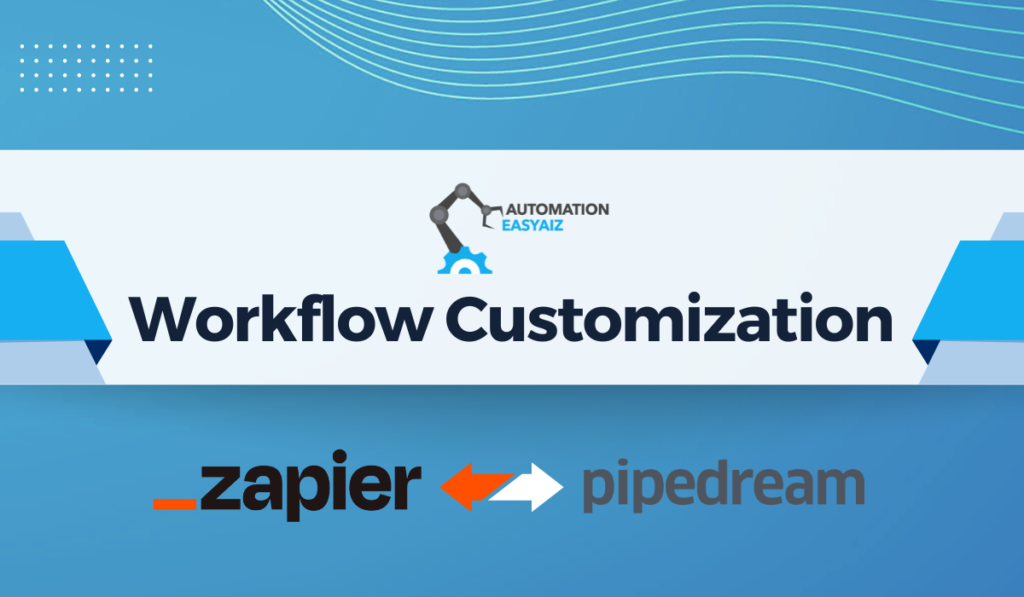Introduction
Connecting apps and services to create automated workflows is crucial to productivity. Are you looking to supercharge? Zapier and Pipedream have you covered. They’re like siblings but with unique styles. Let’s break it down. Check Zapier vs Pipedream with the clear difference in integrations, customization, monitoring, ease of use, pricing, and more. Ready? Let’s roll!
What is Zapier?
Zapier leads the pack in linking apps effortlessly with its excellent “Zaps.” For example, new Slack message > create Trello task. Zapier links 6,000+ apps, which is easy for anyone. No tech hassle – drag, drop, and automate smoothly.
What is Pipedream?
Pipedream is a developer-focused integration platform built on serverless infrastructure. Workflows are created using Node.js code connected to app APIs and webhooks. Pipedream manages the underlying infrastructure, while developers deploy custom JavaScript code to handle app logic in a visual workflow. It is more complex yet flexible compared to Zapier. Pipedream differentiates itself by enabling devs to code their integrations and automation for maximum control.
Zapier vs Pipedream: Key Differences
- Zapier specializes in pre-built connectivity and simplicity.
- Pipedream offers a developer platform for custom-coded workflows.
- Zapier has an easy-to-learn editor for anyone to integrate apps quickly.
- Pipedream requires dev skills for JavaScript workflow creation.
- Zapier is excellent for lightweight automation and individual productivity.
- Pipedream enables developers to build robust custom solutions.
Zapier vs Pipedream: Use Cases
Common Zapier uses cases:
- Essential data synchronization between apps
- Effortless CRM and marketing automation.
- Boost personal productivity and track habits.
- Simple two-step automation like email → calendar
Pipedream use cases:
- Advanced workflows and internal tools
- Teams with developer resources
- Complex business logic and processes
- Building custom integrations and automation
Zapier vs Pipedream: Integration Methods
- Zapier uses pre-built integrations and a simple visual editor requiring no code. Set up takes just minutes.
- Pipedream relies on developers leveraging APIs and writing JavaScript code to connect apps and handle logic. Far more customizable yet complex.
- Casual users get more value from Zapier’s library of pre-made integrations. Pipedream unlocks more potential for devs.

Zapier vs Pipedream: Workflow Customization
- Zapier’s toolboxes are triggers, actions, filters, and delays. Customization is tight, unlike Pipedream.
- Pipedream enables developers to write any custom logic in JavaScript, integrate APIs, control user access, handle errors, and more—far greater capability to enhance workflows.
For simple needs, start with Zapier. For advanced custom requirements, Pipedream empowers devs.
Zapier vs Pipedream: Monitoring and Analytics
- Zapier offers simple process tracking and history. Pipedream provides superior visibility into workflow usage and performance with dashboards.
- Pipedream also enables inserting custom metrics, events, and alerts into workflows using code—far more analytical capability.
For monitoring and analytics, Pipedream is the better choice over Zapier.

Zapier vs Pipedream: Ease of Use
- Zapier excels in ease of use. Their editor enables anyone to create simple automation without coding quickly.
- Pipedream requires JavaScript proficiency for workflow creation and troubleshooting. Beginners will find the learning curve much steeper compared to Zapier.
For non-developers, Zapier is by far the more accessible option. But Pipedream unlocks more potential for devs.
Zapier vs Pipedream: Pricing and Plans
- Zapier begins free, then $19.99-$69.99/month. Your choice!
- Pipedream has a free tier, then paid plans from $19 to $99/month.
For small teams, Zapier provides better value and support. Pipedream offers a more efficient serverless infrastructure for scale.
Conclusion
In summary, Zapier makes it easy to quickly integrate apps and build simple workflows with no code required. It excels at basic automation and connectivity. Pipedream appeals more to devs by providing a serverless platform to deploy custom JavaScript workflows powered by app APIs and webhooks—far greater customization potential yet also complexity. Look at your technical skills and use the case complexity of Zapier vs Pipedream. For simplicity, start with Zapier. For advanced custom needs, Pipedream empowers developers.
FAQs
Can Zapier and Pipedream integrate?
Yes, Zapier can trigger Pipedream workflows and vice versa to combine both platforms’ strengths.
What are the main differences?
Zapier focuses on pre-built integration, while Pipedream offers a developer platform for custom-coded workflows.
Which solution is more affordable?
Zapier has a free forever plan. Pipedream’s free tier is more limited, but paid plans start cheaper.
Who should use each platform?
Zapier: Beginners are seeking simplicity—Pipedream – Developers wanting customization.
Which one is more straightforward to use than the other, Zapier or Pipedream?
Absolutely – Zapier is much more user-friendly. Pipedream requires dev skills.




